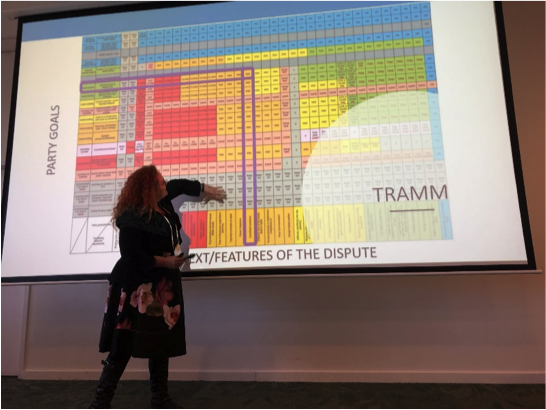National Mediation Conferences are important events. Apart from the great opportunities to network with fellow professionals there is the really important opportunity to see the intersection of research and practice at work.
Last month’s Australia’s National Mediation Conference did not disappoint.
For me the highlight was becoming acquainted with a bold Australian initiative sponsored by the Dispute Settlement Centre of Victoria (DSCV).
Focussing on community disputes about things like fences, trees and noise the Centre had an ambitious plan to:
• devise a reliable process to identify their user profile and the differing levels of complexity their disputes presented;
• adopt the Sander approach and ‘’fit the forum to the fuss’;
• establish realistic settlement rates based on dispute characteristics; and
• develop a realistic budget to ensure the outcome could be realised.
The process – build a strong research base
The first step for the DSCV was to find the right project leader.

They found the perfect custom-made candidate in Danielle Hutchinson. Co-Founder of Resolution Resources, a lawyer, mediator and academic, Danielle was already an ADR Specialist at the DSCV.
Seeking a sound structural base for the project, she drew on 3 key research resources which provided learnings about the relevance of party goals and dispute features namely:
• The Singapore report by Danielle Hutchinson and Emma-May Litchfield (2016)
This was the inaugural report from the Global Pound Conference Series 2016-17. In this report the authors identified the needs, wants and expectations of parties in dispute and placed them on a continuum – creating three levels of ‘dispute-savviness’ – the expert dispute resolver, the competent dispute resolver, and the ineffective dispute resolver.
• Why do people settle? by Julie Macfarlane (2001)
In her paper Macfarlane examines the assumptions and behaviour of participants in dispute settlement processes – enhancing our understanding of why some disputes settle, and others do not.
Her key argument is that it is how disputants see things and how they make sense of their conflicts that have the greatest influence on outcomes – a significant step away from the rational, predictive model emphasized by most legal scholarship.
• Matching Cases and Dispute Resolution Procedures (2006) by Frank Sander and Lukasz Rozdeiczer
The significance of this work is the authors’ analysis of disputes leading to guidance for lawyers and their clients’ in:
• selecting a particular process and then
• designing a new or hybrid process specifically fitted to the needs of the parties.
They proposed that matching processes may be just the first step of the process choice. What needed to follow was the parties modifying their preferred procedure to suit the particular needs of their dispute.
And so TRAMM was born!
Triage resourcing Modality Matrix is more than a mouthful.
What it does is:
• Collects and makes sense of all the information collected at intake;
• Factors in the context of the dispute;
• Identifies the process that is the best match for the parties (Triage);
• Allocates appropriate resources; and
• Uses ongoing satisfaction measures to validate triage consistently.
How it works – a psychometric approach to creating an analytical tool

The tool presents a compelling visual of everything in play when the DSCV is first contacted. The tool has:
• A vertical axis factoring in parties aspirations and goals and linking them to the likelihood of resolution (drawing on Hutchinson & Litchfield and Sander’s work); and
• A horizontal axis identifying and ranking factors likely to help or hinder resolution (drawing on the research of Sander and Macfarlane).
The output?
The power of the tool is in combining the two hierarchical axes to:
• Predict an outcome;
• Recommend the dispute resolution process that is most resource-effective and best for the dispute; and
• Maximise opportunities for a good outcome.
The human element
Trained mediators, operating as dispute assessment officers, input the data from an initial telephone assessment.
They make their own assessment of likely resolution and the best process to use. This is used to continually test TRAMM’s accuracy against that of experienced assessors.
The results are remarkable!
The big picture is more complex that there is room for in this blogpost however a few key outcomes caught my attention:
• TRAMM is outperforming human operators in matching parties to processes and in predicting outcomes;
• The linkage to the Singapore Report and its identification of ‘dispute savviness’ really shows its value here. The emerging data from TRAMM provides the opportunity to explore and demonstrate whether:
o ‘dispute savviness’ makes dispute goals more realistic and more amenable to resolution;
o disputants lacking ‘dispute savviness’ have a disproportionately higher impact on likelihood of resolution and whether it is a wise investment to target them in the preparation process and coach them to higher levels of ‘dispute savviness’; and
o whilst one of the intentions of the project was to maximise resource effectiveness it was not conceived as a cost-cutting exercise.
This is a great outcome
In particular there are 2 overarching achievements that deliver a loud message:
• at a time when the academic and practising worlds seem far apart this is a case study in what happens when we bring them together. One and one has truly made three; and
• when a good outcome, rather than forcing budget cuts, is the goal we do the right thing for the right reason – and surprisingly, as happened here, more cost effective outcomes often result.
Well done Danielle and DSCV
________________________
To make sure you do not miss out on regular updates from the Kluwer Mediation Blog, please subscribe here.



The International Mediation Institute are immensely proud to have helped carry on Frank’s legacy, through the Global Pound Conference Series and its reports (including the Singapore Report). We are delighted to now see this legacy and these learnings continue to inform theory and practice in ADR. Congratulations on the TRAMM initiative, and we look forward to hearing more as it progresses.
For those who are interested in learning more about the GPC, its supporters and reports, please see:
* About – https://www.imimediation.org/research/gpc/gpc-about/#about-gpc-series
* The supporters – https://www.imimediation.org/research/gpc/gpc-supporters/#support-gpc
* Series data and reports (aggregated reports) – https://www.imimediation.org/research/gpc/series-data-and-reports/#909-reports
* Direct link to Singapore Report: https://www.imimediation.org/download/909/reports/35495/the-singapore-report.pdf
Laura Skillen
International Mediation Institute
Thanks for this update Rosemary. What a great development! The Global Pound Conference benefited greatly from Resolution Resources’ expertise and active support throughout the data-gathering process, and it is wonderful to see how Danielle and Emma-May have been able to develop the unique international data this initiative was able to generate and turn it into a practical triage tool. Thanks again to them, to the International Mediation Institute (IMI), to our sponsors and to all members of the Central Organising Group and Local Organising Committees, without which this ambitious experiment would never have been possible.